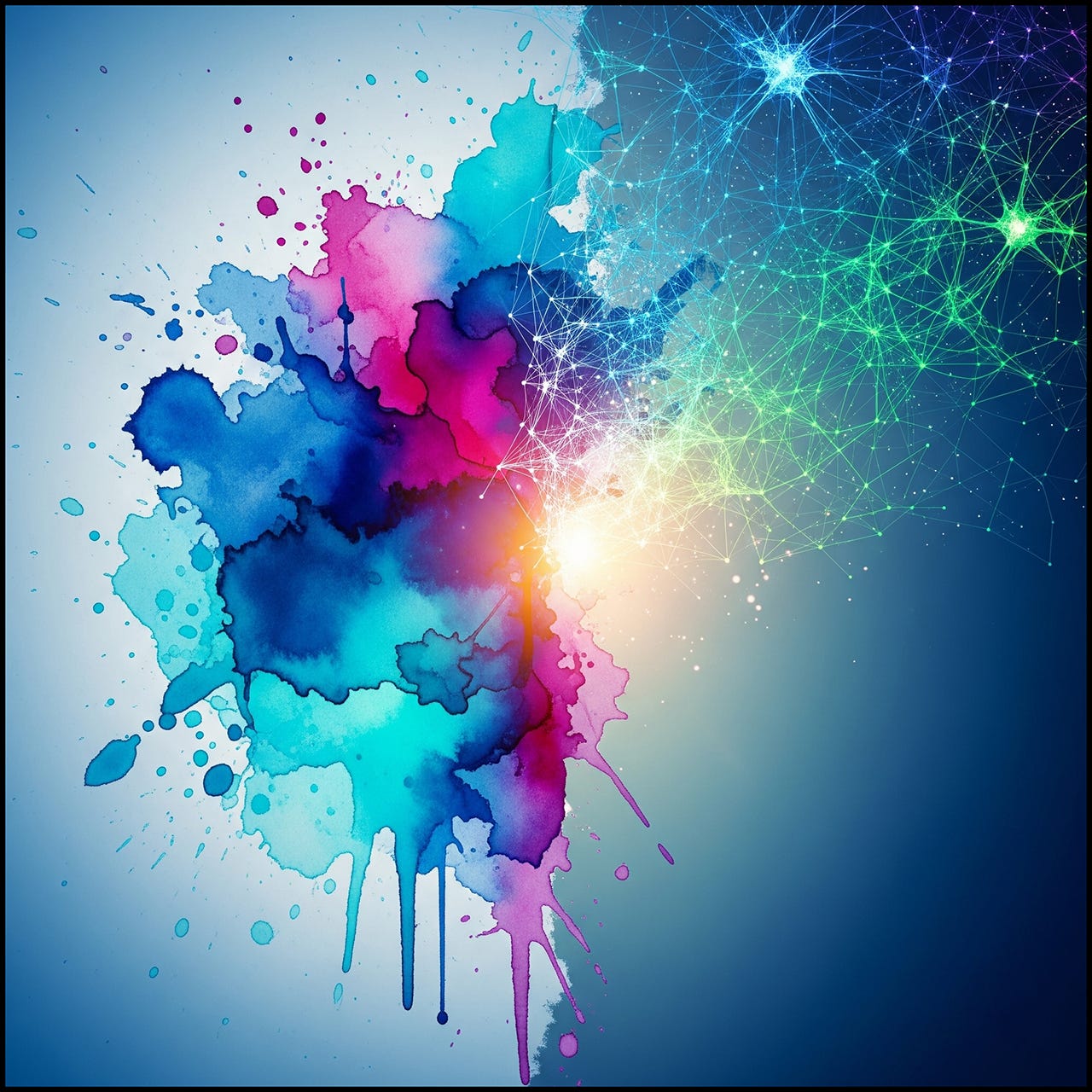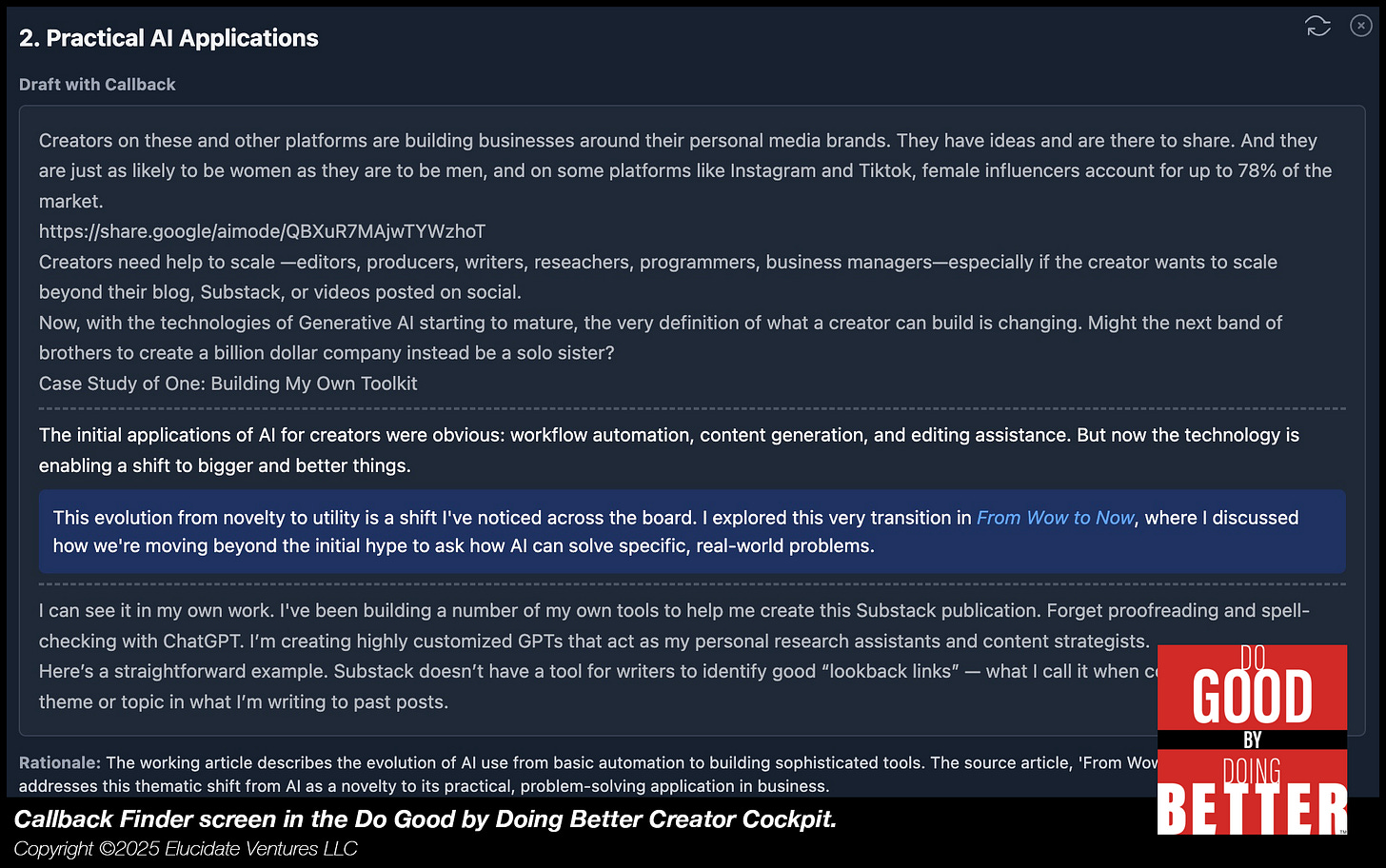From Creator to Architect: The New Entrepreneurial Frontier
Why the next great technology innovator may be a Creator you already follow.
What does it take to nurture a spark of inspiration into a product or a company?
There’s a common storyline to Silicon Valley founder mythology that goes something like this: a lone genius or small band of technically-minded guys get together, build something in a garage, and it takes off, becoming a household name.
Every generation since the start of the computer age has examples of this story.
Boomers have Steve Jobs and Steve Wozniak who started Apple in Jobs’ family garage. Bill Gates and Paul Allen reportedly spent time working in a garage in Albuquerque, New Mexico as they were cooking up ideas for what would become Microsoft.
Gen X has Larry Page and Sergey Brin. They were Ph.D. students at Stanford in the mid-90s working together on a project they called "Backrub" (yes, really). Their idea was to analyze the link relationships among websites and rank them based on the number and importance of links to them.
Sound familiar? The duo developed that technology and formed Google in 1998…when they were working out of a friend's garage in Menlo Park.
Not to be outdone, Millennial Mark Zuckerberg and three college friends skipped the garage and went directly to the dorm room, launching what would become the global social platform we know today as Facebook.
This dominant founder mythology has stayed consistent for generations, but it’s incomplete and leaves out the contributions of women and larger teams of collaborators.
Cisco, perhaps the single most important company in making the internet possible, was started in 1984 by Leonard Bosack and Sandy Lerner, married computer scientists at Stanford University, based on their work to connect computer systems across the school’s campus.
And VMware, which made hardware virtualization possible at scale, was founded by a team of five, made up of women and men: Diane Greene, Mendel Rosenblum, Scott Devine, Ellen Wang, and Edouard Bugnion. Greene was the company’s first CEO.
It’s not a secret that for decades, factors from social norms to persistent hiring biases have resulted in technology being a male-dominated field.
What if that model, however, is about to be democratized?
What if the next wave of innovators aren't just software developers, but Creators, who are just as likely, if not more likely, to be women than men?
Three forces are converging that might just make that a real possibility, and perhaps in doing so bring about a true “more than the sum of the parts” outcome.
Part One: Digital Domination in Media
For two decades, digital media platform companies like YouTube and now streaming providers steadily eroded the reach and economic vitality of traditional media with a massive, diverse deluge of online content delivered on demand.
As analyst and media cartographer Evan Shapiro points out, YouTube is now the largest television platform on the planet. YouTube now attracts more viewers on TVs than Netflix, Amazon Prime, or Disney+. Netflix and YouTube alone accounted for 20% of all television viewing time in May 2025, according to The New York Times.
And it’s not just video - YouTube is also rapidly growing its podcast presence. In February 2025, eMarketer reported data from Edison Research that “YouTube is the most-used platform for listening to podcasts,” and that “Thirty-one percent of weekly and 33% of monthly podcast listeners said YouTube was their preferred platform, ranking higher than Spotify (27%) and Apple Podcasts (15%).”
Part of YouTube’s success is that they can serve both video and audio listeners. eMarketer’s Jeremy Goldman cites research to back that up, with “53% of podcast audiences now watching on the platform” and that “42% of US adults prefer podcasts with video elements.”
YouTube has a baked-in advantage: a nearly endless supply of content provided for little to no upfront cost by—you guessed it—Creators. It’s led to the so-called “golden age of content” that we’re currently in where if you want to find something out, or watch a show you heard about, more than likely it’s just a few clicks away.
Part Two: Creators Being Who They Are and Doing What They Do
Creators on platforms like YouTube, Spotify, Apple Podcasts, and others are building businesses around their personal media brands. They have ideas and are there to share. They are also just as likely to be women as they are to be men, and on some platforms like Instagram and TikTok, female influencers account for up to 78% of the market.
To grow, Creators need to bring others along for the ride—editors, producers, writers, researchers, programmers, business managers—especially if the Creator wants to scale beyond their blog, Substack, or videos posted on social platforms.
With the technologies of Generative AI (AI) starting to mature, the very definition of what a Creator can build themselves is changing.
Might the next band of brothers to create a billion dollar company instead be a solo sister?
Part Three: The Rise of the AI-Powered Architect and Developer
It became clear early on that Large Language Models contained vast repositories of code in their training, and that led to developers copy and pasting code into Claude, Gemini, and ChatGPT to troubleshoot, explain, and create new code.
The development ecosystem has rapidly evolved, and now integrated development environments (IDEs) like VS Code can insert AI assistants right into the software engineering workflow. Cursor has established a leading reputation as a comprehensive AI coding editor, OpenAI developed Codex, and Google recently introduced the Gemini CLI which integrates directly with VS Code and other editors.
Especially noteworthy is a recent retooling of AI Studio, another Google product, now relaunched as a rapid prototyping tool with more technical knobs and switches than the standard Gemini chat interface.
AI Studio can flex from “what do you want to build today?” to creating a UI and application, and then deploying code directly to the cloud. It’s a novel hybrid of IDE, code-it-for-me agent, and with Google Cloud integration, an app hosting platform.
Translation: AI Studio is an AI-powered toolset that can architect, develop, and engineer basic apps for you that can be published to a publicly-available URL. It dramatically lowers the barrier to entry for building, testing, and launching a functional application.
This move towards building practical, problem-solving tools mirrors a shift I've been seeing in industry as we move From Wow to Now in our relationship with AI.
This isn't just theory. I’m actively using an app created with AI Studio in my production workflow for Do Good by Doing Better.
Here’s a straightforward example…
Substack doesn’t provide a tool for writers to identify good “callbacks” — references connecting a passage in a new draft to something I’ve written about in a past post.
I built a small app (not a prompt, not a custom GPT…an actual app) that analyzes the text of my draft and finds semantically related topics from my archive, proposes a short callback reference, and shows it to me in context of the current draft. It allows me to provide a range of more interconnected content for you, and it helps my body of work go further.
To illustrate, I’ve included a view of the Callback Finder screen below suggesting a callback, which I then edited and inserted four paragraphs above (the From Wow to Now reference).
I created a suite of tools, all integrated into a single app, that I call the Do Good by Doing Better Creator Cockpit. It’s my own bespoke app to assist with a variety of production and analysis tasks, and I am starting to use it throughout my production process.
How long do you think it took me? So far, I’ve spent a few hours on nights and weekends over the past two weeks on it. I have many more functions on my wish list to add. And you can bet I’m going to keep going on it.
This ability for non-developers to leverage AI for building functional apps is a tangible example of why The AI Skills Gap Is About To Get Real, creating a competitive advantage for those who adapt and embrace AI.
A New Business Model for the Digital Age
So, where are we headed? I see an intersection where the Creators driving the Creator Economy expand beyond content and brand to be Creators of startup apps, systems, and even platforms. Imagine a Creator who builds a loyal audience, identifies a need within that community, and can build an app to address it in a few days or weeks.
This could be a watershed moment. For decades, the high barrier to entry in tech has meant that a huge portion of the population has been underrepresented in the creation of the very tools that shape our world. My personal belief is that we are leaving 50% of the best ideas on the table. With the global challenges we face, we simply cannot afford to let so much ingenuity and perspective go untapped.
AI Studio shows we’re getting close to a "WordPress for apps" that enables the creation of hyper-niche SaaS products tailored to specific communities, AI-powered consulting tools that scale expertise, and automated platforms that serve passionate audiences.
A lower barrier to entry for technology-enabled entrepreneurship would allow innovation to flourish far beyond traditional tech hubs. It would empower individuals around the world to unlock a true Co-Creator economy built on collaboration.
The convergence of Creator-led collaborations and accessible AI-powered development tools could lead to a new wave of creative innovation where both women and men can build their own share of wealth on their own terms, and critically, make an impact for causes they care about.
We’ll still need full-stack development teams for large-scale operations, and experts in data security, regulatory compliance, and customer support. But a "Goldilocks zone" is emerging, where a one- or two-person shop can turn an idea into a revenue-generating and service-providing reality.
Points of Departure
As I’ve laid out, the shift from content to application creation isn't just for a select few. It represents a fundamental change in how we can all solve problems and create value. Here are a few ways to start harnessing this potential:
Identify a Personal Pain Point. Think about your own daily workflow, whether it's professional or personal. What is one repetitive, time-consuming task you wish you could automate? Sketch out on paper what a simple app to solve that problem would do. The first step is clearly defining the problem. Don’t try to solve too much right out of the gate.
Experiment with a Tool. You don't need a computer science degree to get started. Go to a platform like Google's AI Studio. Try its starter prompts for building a simple web app. The goal isn't to become a developer overnight, but to demystify the process and see what's possible.
Shift Your Mindset. The next time you identify a need within your community, team, or industry, resist the urge to think, "someone should build a solution for that." Instead, ask yourself, "What would a solution for that look like, and could I be the one to start building it?" Then open AI Studio or your preferred tool and see what you can whip up.
I’ve always been compelled by the opportunity to realize potential, and I see a huge new door opening here.
I’m betting on the ingenuity of the Creator community, in all of its diversity, to walk through it and find new entrepreneurial opportunities in the adjacent possible.
It’s exciting, and I’m already deep into being a part of it. I invite you to join along on the journey too.
Related Reading
From Wow to Now
Last year, the buzz around AI was reminiscent of the dot com boom in the late 90’s. We were standing at the edge of a new frontier, with everyone talking about how fast things were changing, the immense possibilities in front of us, and how all kinds of new commerce and businesses would be born.
The AI Skills Gap Is About To Get Real
The weather this past Thursday morning in Philadelphia was brisk. Still ensconced in a warm blanket with a cat cuddled next to me, I opened my eyes and lifted my arm to see my watch report that the outside temperature was 19°F. I knew I’d better bundle up before heading out!






